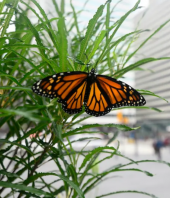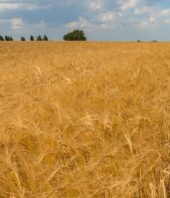The California overwintering population has been reduced to less than 0.5% of its historical size, and has declined by 86% compared to 2017.
Each year, during a three-week period around Thanksgiving, scores of volunteers fan out through coastal California to find and count overwintering monarch butterflies as part of the Western Monarch Thanksgiving Count. The results are eagerly awaited, as the count provides the best estimate of how well this beloved butterfly is doing. We’re reaching the end of the 2018 count period, and while we do not have all the data in yet, the count numbers that are coming in from volunteers, regional coordinators, and Xerces staff who traveled to California overwintering sites are disturbingly low.

Overwintering groves in coastal California provide monarchs with shelter during the winter. The annual gathering of butterflies gives a great opportunity to assess the health of the western monarch population. (Photo: Xerces Society / Candace Fallon)
Going into the overwintering season, we were not expecting this to be a great year because we knew it had been a rough season in the breeding and migratory range (read more about this in Xerces’ recent blog here). It’s worse than anyone had anticipated, however, with early count numbers showing that the population is down an order of magnitude from last year, which was a low population year itself. We currently have preliminary count results from 97 sites, which includes many of the most important overwintering sites. In 2017, these sites accounted for 77% of the total monarch overwintering population, hosting approximately 148,000 monarchs. In 2018, the same sites have only 20,456 monarchs. This represents an 86% decline since last year.
We will not have final numbers until the count is over and all the data are in and vetted (usually late January)—and we will keep our fingers crossed that other sites are hosting more monarchs. However, we are very troubled to observe such an apparently large decline in the population this year. While overwintering populations naturally fluctuate, even by double digit percentages, the magnitude of this year’s drop is of significant concern because the monarch population was already at a new low after the 97% decline it has experienced since the 1980s (Schultz et al. 2017), leading to a situation which may be catastrophic for the western population.
If the rest of the Thanksgiving Count data show the same trend as the preliminary data, we anticipate seeing less than 30,000 butterflies overwintering in California this winter. In comparison, there were more than 192,000 butterflies counted in 2017, more than 1 million were estimated in 1997, and Schultz et al. (2017) suggest that there were at least 4.5 million monarchs overwintering in California in the 1980s. While a true minimum population size is unknown until we see a migration collapse, 30,000 butterflies is the average quasi-extinction population size (the number of adult butterflies needed to ensure persistence of the western monarch population) explored in a population viability analysis based on expert opinion of a viable western migratory population size (Schultz et al. 2017).
No one knows exactly what caused the decline this year, but we do suspect it occurred between the late overwintering season and early spring. This comes from the data of multiple field projects, including work by scientists from the Xerces Society, Tufts University, and Washington State University–Vancouver, as well as University of California–Davis professor Art Shapiro’s long-term monitoring of butterflies in California, that found monarch numbers were low from the very beginning of the breeding season (March, April) and they never recovered. Early spring is likely a vulnerable period for monarchs because the individuals leaving overwintering sites are more exposed to the elements while being at the end of their life. This decline in early season monarch counts was identified in previous years through analyses by Espeset et al. (2016) of Art Shapiro’s long term monitoring of butterflies across northern California. Authors of that study suggested that “mortality could be increasing either during or immediately after overwintering.” (See the end of this blog for some ways you can help monarchs during this critical time of year).

At a private site in Big Sur, monarchs cluster on a young blue gum eucalyptus under Hwy 1. In years past, this site has hosted over 10,000 monarchs; this year, it hosts less than 1,000. (Photo: Xerces Society / Emma Pelton)
It may be tempting to blame the weather for this year’s drop in numbers, and it may have played some role. There were late rainy season storms that swept across California in March. There was a severe and extended wildfire season in California and, to a lesser extent, in other areas of the butterfly’s breeding and migratory range. Smoke and bad air quality was widespread in parts of the West at times. California is still recovering from a historic drought.
It is not just monarchs that have had a tough year in California. According to Matt Forister, a professor at the University of Nevada-Reno, many butterfly populations at high elevations are still recovering from California’s historic drought. Art Shapiro, a professor at the University of California-Davis, who runs the long-term butterfly monitoring program in northern California, said by email that “MANY species on my transect are in trouble this year, with several no-shows at particular sites for the first time ever. Whether this can be attributed to a single cause remains to be seen. It’s far too early to say.”
Some people have wondered if the monarchs are simply somewhere else, if they will arrive later. However, we do not think there is much evidence of a delayed migration. Monarchs are not being reported in large numbers elsewhere in their range and Thanksgiving counts are not generally increasing despite repeated visits by volunteers eager to see an uptick. In addition, two years of the New Year’s counts have suggested that monarchs do not generally arrive later than the Thanksgiving count period at the coast, at least in large numbers. Over the past two years, we have seen that New Year’s counts in early January are 40–50% lower than Thanksgiving counts in November.
In short, 2018 was a tough year to be a monarch butterfly in the West. But that in and of itself would not have led to the crisis we are currently seeing: These historically low numbers follow a long period in which monarchs have declined 97% since the 1980s. In my lifetime, the monarch population in California has gone from millions of butterflies to hundreds of thousands and now, possibly, mere tens of thousands. This is despite all the attention monarchs have received in the last few years and efforts by federal and state agencies, nonprofits, and many others to conserve them and their habitats. All this work has clearly not been enough to save western monarchs. So while western monarchs appear to be suffering from some particular bad luck this year, the real concern is that the population may not be able to bounce back from this very quickly given the cumulative impact of all the stresses the population has been facing for years and years.
The major stressors affecting western monarch include habitat loss (overwintering and breeding), pesticides (herbicides and insecticides), and climate change including increased drought severity and frequency. These long-term stressors are what we all need to be paying attention to and addressing. We cannot change the weather to prevent the occasional wet, late spring storm or drought or wildfire from impacting monarchs—although we should all be working towards curbing the causes of climate change to avert the worst-case scenarios and using adaptive management as we can. What we can and should be working on is addressing and reversing widespread habitat loss and pesticide use throughout the monarch’s range, continuing the work that has already been started.

Where there should be great gatherings of monarchs, only tiny numbers of butterflies are clustering this year. This photo was taken during this year’s Western Monarch Thanksgiving Count by a WMTC county coordinator. (Photo: Charis van der Heide)
Interestingly, the eastern monarch population had a favorable year in their breeding grounds and overwintering numbers in Mexico are expected to be relatively positive. However, the eastern population has also undergone an estimated 80% decline since the mid-1990s (Semmens et al. 2016). As the eastern and western populations are genetically indistinct, the populations’ breeding grounds likely overlap in the Intermountain West, and some western monarchs (especially from the Southwest) overwinter in Mexico, there is hope that a spill-over effect next year as butterflies return from Mexico may help boost numbers in the West next season (Vandenbosch et al. 2007).
Next year will be a real test in how resilient the western monarch population is, after its California overwintering population has been reduced to less than 0.5% of its historical size.
The western population’s dire straits should be an urgent call to action for state, federal, and local governments, industry, agricultural producers, conservation groups, and the public to step up conservation efforts. If we want to have monarchs migrate through the western U.S., as they have for centuries, sustained work is needed. Three decades of decline won’t be overturned quickly. Key areas to focus habitat protection and restoration efforts include overwintering sites and breeding habitat in California, particularly the Central Valley and foothills. Elsewhere in the western states, important breeding grounds for monarchs can be found in eastern Washington and parts of Oregon, as well as the Snake River Plain of Idaho, areas where habitat has likely been lost. In other locations where monarch habitat already exists, such as in Nevada, Arizona, and Utah, continued protection and management is recommended (See Xerces’ Managing for Monarchs in the West to learn more).
While western monarchs are facing unprecedented challenges right now, there is still hope that we can recover the population if we work quickly, strategically, and together. Whatever work we do to protect or restore monarch-friendly habitat will also benefit many other pollinators such as bees and other butterflies, as well as many other wild and beautiful insects that are a cornerstone of ecosystems and provide us with a deep sense of connection to our natural world.
On an individual level, people can help by:
- • Looking for milkweed, monarchs, and especially monarch caterpillars, and reporting them on the Western Monarch Milkweed Mapper. More sightings in late winter and early spring (February–April), the period monarchs leave the overwintering sites, are particularly important to capture as this is when they seemed to disappear in 2018 and the stage of the migratory cycle about which we know the least.
- • Planting nectar resources which bloom throughout the season—especially species which bloom during spring and fall migration. In some areas, it is generally advisable to plant perennial plants now, during the fall. Annuals that bloom early in the season can be planted in February to April. Check out Xerces’ monarch native nectar plant guides for plant guidance.
- • Planting native milkweed species where appropriate (in regions where they naturally occur; typically not within 5–10 miles of overwintering sites in central and northern coastal California). If you live in California, planting early emerging species such as heartleaf milkweed (Asclepias cordifolia) or woollypod milkweed (Asclepias eriocarpa) may be especially important.
- • Reduce or eliminate pesticide use, particularly insecticide use. Check out Xerces’ pesticide resources to learn more. Support agricultural producers who minimize pesticide use and provide wildlife habitat.
Note: We do not recommend rearing monarchs in your home as a conservation strategy. Read this recent Xerces’ blog to find out why.
Thank you to the Thanksgiving count regional coordinators and volunteers for providing data which makes all of this possible. Thank you also to Scott Hoffman Black, Katie Hietala-Henschell, Sarina Jepsen, and Stephanie McKnight of the Xerces Society; Elizabeth Crone of Tufts University; Matt Forister of University of Nevada-Reno; Cheryl Schultz of Washington State University–Vancouver; and Art Shapiro of University of California-Davis for providing comments to improve this blog and perspectives about the state of this year’s population.
Written by Emma Pelton, Xerces Society Endangered Species Conservation Biologist
Source: Xerces, Full Article






